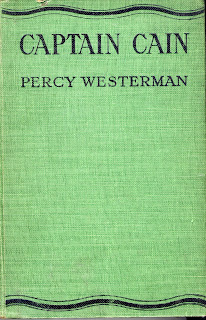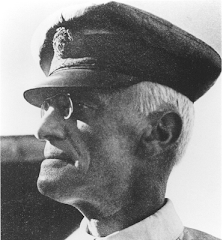James is the author of 'Another Country: A guide to the children's books of the Lake District and Cumbria'; an absolute must for your holiday reading on your next visit to the region. James also manages the specialist weblog http://www.childrensbooksofthenorth.blogspot.com/.
Thanks James
‘I must hand her over to the new owner before the end of the present month, Gerald,’ declared Rollo Vyse, owner of the thir
 ty-five feet motor-yacht, Ibex, to his chum Gerald Broadmayne.
ty-five feet motor-yacht, Ibex, to his chum Gerald Broadmayne.This is the opening sentence of Chapter VI of ‘The Pirate Submarine’ and is 65 pages in to the storyline of this unusual story. It seems an extraordinary long time for the reader to wait for the arrival on the scene of the two characters who seem destined to be the heroes of the tale.
Yet, all in this book is not quite what it seems.
The opening chapters tell of the doings of two of the biggest villains ever to grace the pages of this author. They are Tom Trevorrick and Paul Pengelly, the rogues who are about to bring disgrace to all Cornish mariners. We see how they pass from shady business dealings just on the right side of the law to a life of outright crime. Dismantling surplus ex-Royal Naval ships in order to sell them for scrap value is not a particularly unorthodox way for former sailors to make a living. When the value of brass falls to an uneconomic level they know that they must find another way to bring in the cash. Very soon they must answer to their shareholders who will demand a dividend for their risky investments. There are also the employees who need paying.
Trevorrick’s solution to the problem is both simple and startling. They will save a doomed ship, disguise it, sneak it out on to the Channel and turn it into a modern day pirate. The whole idea seems totally preposterous. Yet such is the application of the writer to his craft that Westerman starts devising a cunning account of how they can set about their nefarious scheme. He deals with the practical details of getting the discarded submarine ready for her voyage. The location of the small shipyard is a neglected creek not far from Falmouth. The rogues have the location and the facilities to prepare their chosen vessel. The workforce have been especially selected to be rootless and without close dependents. They are invited to join a salvage expedition which will remove gold bars from a sunken vessel. Secrecy is essential if rivals are not to discover the precious wreck and steal their prize. The local Inspector is a mere cipher more intent upon drawing his pay for very little work than checking what happens to the decommissioned men of war.

Trevorrick’s command of the human factor in his plan is never in doubt. The men commit themselves to one risky but not illegal exercise and find themselves ready for something more outrageous when these plans seem to go wrong. The Naval inspector is duped and then overpowered and kidnapped when he stumbles into the wrong place at the wrong time.The disguised submarine can only make progress on the surface (no underwater engines can be operated) but it can rise and submerge on the spot. Each problem that arises is overcome by Trevorrick’s sheer nerve and inventiveness. He soon has a Cornish crew committed to piracy and even has a local smuggler to transport and handle the stolen goods. He has also adopted his nomme de guerre Captain Cain.
At page 65, by an unhappy accident ,the pirate submarine Alerte rises from the water and rescues Vyse and Broadmayne from the dinghy of their burnt out motor cruiser. At this point the pirates’ plans begin to unravel. The rest of the book recounts the adventures up to page 296 when the unlucky Alerte reaches its final resting place. You might expect that Vyse and Broadmayne find their own way of outwitting the pirate and undoing his schemes. Very soon, for example, Broadmayne manages to win the approval of some of the pirate crew by defeating their champion in improvised boxing match.
‘Tough,desperate ruffians they might be, but they were sportsmen, members of a race that produces the best winners and the best losers in the world.”

Captain Cain keeps his men in check by promising that they will never be called on to fire at an English ship. Somehow he also can’t bring himself to deal with the young heroes that may have been brutal but which would have been sensible. Somehow in return the youths feel a grudging respect for the man who has them prisoner. Later, however, they both play their part in trying to hunt him down. By the end of the book the rascally and cowardly Pengelly has gone to his fate in prison. Yet the sheer defiance and unnatural courage of Captain Cain stays with him to the end. In fact Broadmayne’s final reflections suggest something more. He ponders over what happened to Cain ?
‘It was to him a fascinating and yet unsolved mystery. Did Cain succeed in his last desperate attempt to escape ? Or did the bed of the land-locked Bahia Arenas hold the secret of the fate of the pirate submarine until the sea gives up its dead ?’
Now that I see the title ‘Captain Cain’ as Westerman’s next book for the same publisher in the following year I realise what the conclusion must be. You can’t keep a good (or a bad) man down.
James Mackenzie






